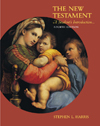

 The New Testament, 4/e Mark's Portrait of Jesus: The Hidden Messiah and Eschatological Judge Outline
|
 2002 McGraw-Hill Higher Education
2002 McGraw-Hill Higher EducationAny use is subject to the Terms of Use and Privacy Policy.
McGraw-Hill Higher Education is one of the many fine businesses of The McGraw-Hill Companies.